Maintaining good oral health is an essential part of general health. Dental problems can be both painful and costly to treat, making prevention and early intervention crucial.
1. Tooth Decay (Cavities)
Tooth decay is a frequent dental problem. It occurs when the outer layer of the tooth (enamel) is damaged by acids produced by bacteria in the mouth. Common symptoms include tooth sensitivity, pain, and visible holes in the teeth.
Solution: The treatment for cavities typically involves removing the decayed section and filling the cavity with materials like amalgam or composite resin. To prevent cavities, maintain good oral hygiene practices, such as regular brushing, flossing, and limiting sugary and acidic foods.
2. Gum Disease (Periodontal Disease)
Gum disease is an infection of tissues surrounding the teeth. It often starts as gingivitis, characterized by swollen, bleeding gums. If left untreated, it can turn into periodontitis and lead to tooth loss.
Solution: Early-stage gum disease can often be reversed through improved oral hygiene practices, such as regular dental cleanings and proper brushing and flossing techniques. In more advanced cases, treatments like scaling and root planing, antibiotics, or surgery may be necessary. Regular dental check-ups can address gum disease in its early stages.
3. Tooth Sensitivity
Tooth sensitivity is a common issue characterized by discomfort or pain when consuming hot, cold, sweet, or acidic foods and beverages. It can be caused by various factors, including enamel erosion, gum recession, or exposed tooth roots.
Solution: Depending on the cause of sensitivity, solutions may include using desensitizing toothpaste, applying fluoride treatments, or using dental sealants to protect exposed root surfaces. In some cases, your dentist may recommend more extensive treatments, such as dental crowns or inlays.
4. Toothaches
Toothaches can result from various dental issues, such as cavities, gum disease, cracked teeth, or dental abscesses. Toothaches can cause mild to severe pain and may be accompanied by swelling and fever in the case of an infection.
Solution: The treatment for a toothache depends on its underlying cause. It’s crucial to see a dentist promptly for an accurate diagnosis and appropriate treatment. Over-the-counter pain relievers may provide temporary relief until you can see a dental professional.
5. Bad Breath (Halitosis)
Persistent bad breath can be embarrassing and is often a sign of underlying dental or health issues. Common causes include poor oral hygiene, gum disease, dry mouth, or the presence of oral bacteria.
Solution: Addressing bad breath often involves improving oral hygiene practices, including regular brushing and flossing, tongue cleaning, and staying hydrated. If the issue persists, your dentist can help identify the cause and recommend treatments, such as professional cleanings or addressing specific dental conditions.
6. Teeth Grinding (Bruxism)
Bruxism is the grinding or clenching of teeth, typically during sleep. Over time, it can lead to worn enamel, tooth sensitivity, jaw pain, and even cracked or fractured teeth.
Solution: Dentists may recommend custom-made nightguards to protect teeth from grinding during sleep. Stress management techniques and relaxation exercises can also help reduce bruxism. In severe cases, dental treatments like crowns or orthodontic procedures may be necessary.
7. Crooked or Misaligned Teeth
Crooked or misaligned teeth can affect not only your appearance but also your oral health. They may be more challenging to clean, increasing the risk of cavities and gum disease. Additionally, misalignment can lead to bite issues and jaw pain.
Solution: Orthodontic treatments like braces or clear aligners can correct crooked or misaligned teeth, improving both appearance and oral health.
8. Oral Cancer
Oral cancer can affect the lips, tongue, cheeks, and throat. Early detection is crucial for successful treatment.
Solution: Regular dental check-ups are essential for the early detection of oral cancer. Dentists can perform thorough oral cancer screenings during routine examinations. If any suspicious lesions or growths are detected, a biopsy can be performed.
9. Tooth Loss
Tooth loss can occur due to trauma, gum disease, or tooth decay. Missing teeth can impact your appearance, speech, and ability to chew properly.
Solution: There are several options for replacing missing teeth, including dental implants, bridges, and dentures. Your dentist will assess your specific situation to determine the most suitable replacement option.
10. Stained or Discolored Teeth
Stained or discolored teeth can be caused by various factors, including tobacco use, consumption of staining foods and beverages, and poor oral hygiene.
Solution: Teeth whitening treatments, either performed in a dental office or using at-home kits prescribed by a dentist, can help remove stains and whiten teeth. Maintain good oral hygiene practices to prevent future staining.
Good oral health is vital for overall well-being, and addressing common dental problems promptly is key to preventing more significant issues. Remember that prevention and early intervention are often more cost-effective and less painful than treating advanced dental problems.

